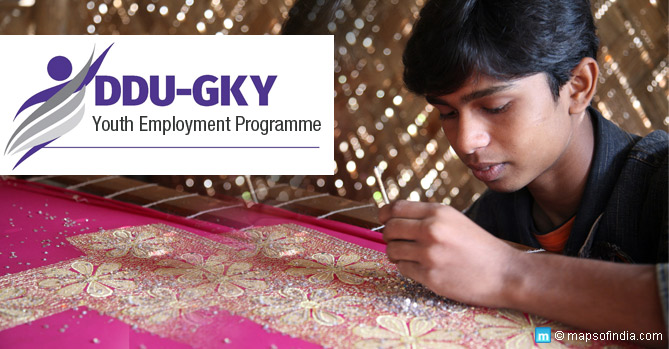Deen Dayal Upadhyaya Grameen Kaushalya Yojana (DDU-GKY) is a youth employment programme of the Indian Government. It was launched by Venkaiah Naidu and Nitin Gadkari on 25 September 2014. It was the 98th birth anniversary of Pandit Deen Dayal Upadhyaya, a prominent figure in Bharatiya Jana Sangh, the predecessor of BJP. Its main aim is to help people in the age group of 15-35 years and train a million young individuals in India by 2017, which can be regarded as a courageous target of sorts.
This programme is a re-launched version of the rural skilling programme already in operation, known as Aajeevika Skills, and is being done in a public-private partnership method.
Broader Objective
The minimum age of entry in that programme was 18, but in the new scheme the lower limit was brought down to 15. As part of the programme, the government had stated that it would keep looking for new skills to enhance the same. It had also planned to start at least 1000-2000 training centres across India by 2016 and is also expected to spend in the region of INR 15,000-20,000 crore for the same. It is also expected that by training in this programme, people in India would be able to work in countries and regions such as the following:
- China
- Japan
- The US
- Middle East
- Germany
- France
- Spain
The government has seen that the demand for labour is quite high in these countries and it feels that with proper training, trained rural youth will find jobs over there. They expect that these youth can earn in the region of $500. For Indians working at home, the earnings per month could be at least INR 6000.
In-depth study
While launching the programme, Gadkari – the Union Rural Development Minister – had asked officials to carry out detailed studies of skills that are accessible to workers in other countries so that the scope of training could be widened and those skills could be adapted in India as well. He had especially mentioned countries such as the US and China. He had asserted that the workers in India knew 1600 skills while workers in China know 4500.
Use of SECC data
In order to make the programme more effective, the Indian Government had planned to use the Socio-Economic and Caste Census (SECC) data. The idea is to assist the rural poor in 56,000 gram panchayats on high priority. There are around 2,38,000 such panchayats in the country, which means that the said number accounts for almost 25% of the count. These panchayats had been selected on the basis of the coverage done in the Rural Livelihood Mission (NRLM), which was also a programme of the central government to create awareness regarding self-employment.
Position of DDU-GKY programme in scheme of things
In fact, the DDU-GKY scheme is just one of the several ways the Indian Government is trying to help the said villages and others. The other programmes that are supposed to serve a similar purpose and on whose implementation a lot of attention is being given are Mahatma Gandhi National Rural Employment Guarantee Scheme (MGNREGS) and Housing for All. The beneficiaries for the DDU-GKY are listed on the basis of data received from the SECC, which was also the first of its kind after Independence in India.
By using SECC data, the programme has been providing skills training to people who had been working as casual and manual labourers so far. However, as has been pointed out by some members of the Indian academia, one needs to be careful of the criteria being used to select the beneficiaries. Considering the fact that back in 2014 – when the programme was launched – at least 91.6% of the families were engaged in casual and manual labour, a skills training programme like DDU-GKY would be highly beneficial for them. In fact, in rural India, such form of labour still generates the maximum income for the families that belong to depressed classes.
Skills taught in DDU-GKY
The DDU-GKY teaches a wide variety of programmes for people looking for jobs and some of them may be mentioned as below:
- Welding
- Masonry
- Painting
- Domestic nursing of elderly people
- Taking care of banking needs in rural areas
- Background checking
When the programme was launched, it was said that the government wanted to create a certification process which eliminated the need of employment through reputation and prioritised skills. The government – in the recent years – has eliminated several applications because of the same approach. It had also looked to associate with internationally-operative placement agencies and start the concept of rewarding companies that hired manpower trained in the programme.
The long-term benefits
Along with the Make in India campaign, this programme can play a major part in making India an economically-thriving country. The programme has the potential of making India a hub of exporting labour. As per the calculations of the Rural Development Ministry, by 2020, developed countries across the world could be experiencing shortfall of at least 57 million people in semi-skilled works. At the same time, India could have an excess of 47 million. This is where India could be ideally placed to satisfy a major chunk of the demand – if not the whole one.





